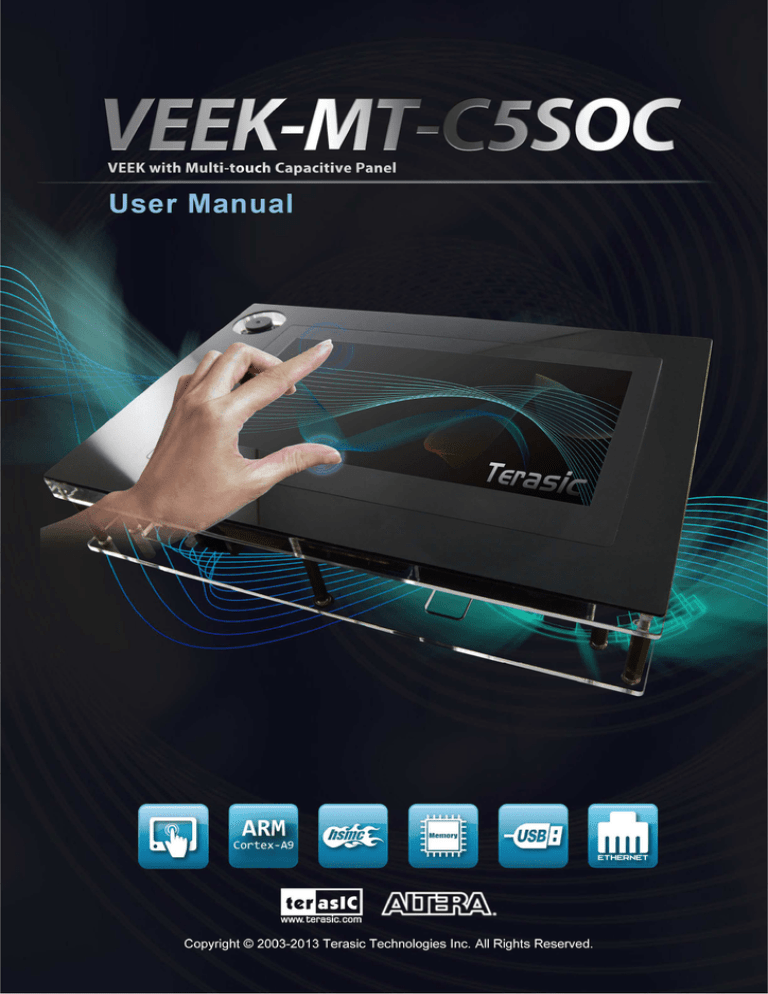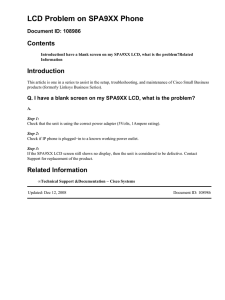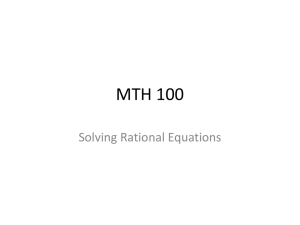
1
CONTENTS
CHAPTER 1
VEEK--MT
MT--C5SOC ................................................................
.................................................................
................................. 1
INTRODUCTION OF THE VEEK
1.1
Cyclone V SX SoC Development Board ............................................................................................. 2
1.2
Setup License for Terasic Multi-touch IP ............................................................................................ 6
1.3
Getting Help ........................................................................................................................................ 7
CHAPTER 2
................................................................................................
............................................................................
............................................ 8
ARCHITECTURE................................................................
2.1 Layout and Components ............................................................................................................................. 8
2.2 Block Diagram of the VEEK-MT-C5SOC ................................................................................................. 9
CHAPTER 3
VEEK--MT
MT--C5SOC ................................................................
............................................................................................
............................................................ 10
USING VEEK
3.1 Using the Cyclone® V SX SoC FPGA .................................................................................................... 10
3.2 Using the 7” LCD Capacitive Touch Screen ............................................................................................ 10
3.3 Using 5-megapixel Digital Image Sensor ................................................................................................. 12
3.4 Using the Digital Accelerometer .............................................................................................................. 13
3.5 Using the Ambient Light Sensor .............................................................................................................. 14
3.6 Using Terasic Multi-touch IP.................................................................................................................... 14
CHAPTER 4
VEEK--MT
MT--C5SOC DEMONSTRATION
DEMONSTRATIONS
......................................................................
...................................... 17
VEEK
S ................................................................
4.1 System Requirements ............................................................................................................................... 17
4.2 Painter Demonstration .............................................................................................................................. 17
4.3 Camera Application .................................................................................................................................. 21
4.4 Digital Accelerometer Demonstration ...................................................................................................... 25
CHAPTER 5
................................................................................................
...................................................................................
................................................... 28
APPENDIX ................................................................
5.1 Revision History ....................................................................................................................................... 28
5.2 Copyright Statement ................................................................................................................................. 28
1
Chapter 1
Introduction of the VEEKVEEK-MTMT-C5SOC
The Video and Embedded Evaluation Kit - Multi-touch on Cyclone® V SOC Development Board
(VEEK-MT-C5SOC) is a comprehensive design environment with everything embedded developers
need to create processing-based systems. VEEK-MT-C5SOC delivers an integrated platform that
includes hardware, design tools, intellectual property (IP) and reference designs for developing
embedded software and hardware platform in a wide range of applications. The fully integrated kit
allows developers to rapidly customize their processor and IP to best suit their specific application.
The VEEK-MT-C5SOC features the Altera Cyclone® V SoC development board targeting the
Altera Cyclone® V SX SoC FPGA, as well as a capacitive LCD multimedia color touch panel
which natively supports multi-touch gestures. A 5-megapixel digital image sensor, ambient light
sensor, and 3-axis accelerometer make up the rich feature-set.
The all-in-one embedded solution offered on the VEEK-MT-C5SOC, in combination of the LCD
touch panel and digital image module, provides embedded developers the ideal platform for
multimedia applications with unparallel processing performance. Developers can benefit from the
use of FPGA-based embedded processing system such as mitigating design risk and obsolescence,
design reuse, reducing bill of material (BOM) costs by integrating powerful graphics engines within
the FPGA, and lower cost.
Figure 1-1 shows a photograph of VEEK-MT-C5SOC.
1
Figure 1-1
The VEEK-MT-C5SOC board overview
The key features of the board are listed below:
1.1 Cyclone V SX SoC Development Boar d
•
•
•
Cyclone V SX SoC—5CSXFC6D6F31C6N
o 110K LEs, 41509 ALMs
o 5140 M10K memory blocks
o 224 18x18 Multiplier
o 6 FPGA PLLs and 3 HPS PLLs.
Configuration Sources
o Active Serial (AS) x1 or x4 configuration (EPCQ256SI16N)
o MAX® V CPLD (5M2210ZF256I5N) in a 256-pin FBGA package as the System
Controller
o Flash fast passive parallel (FPP) configuration
o MAX II CPLD (EPM570GM100) as part of the embedded USB-BlasterTM II for
use with the Quartus® II Programmer
Memory Devices
o One 1,024-Mbyte (MB) HPS DDR3 SDRAM with error correction code (ECC)
support
o One 1,024-MB FPGA DDR3 SDRAM
o One 256-Megabit (Mb) quad serial peripheral interface (QSPI) flash
o One 512-Mb CFI flash
o One 32-Kb I2
2
•
o C serial electrically erasable PROM (EEPROM)
o One Micro SD flash memory card
Switches and Indicators
o LEDs and displays
o Eight user LEDs
o One configuration load LED
o One configuration done LED
o One error LED
o Three configuration select LEDs
o Four on-board USB-Blaster II status LEDs
o One HSMC interface LED
o Two UART data transmit and receive LEDs
o One power on LED
o One two-line character LCD display
o Push buttons
o One CPU reset push button
o One MAX V reset push button
o One program select push button
o One program configuration push button
o Six general user push buttons
o DIP switches
o One MAX V CPLD System Controller control switch
o One JTAG chain control DIP switch
o One mode select DIP switch
o One general user DIP switch
•
On-board Clocking Circuitry
o Si570, Si571, and Si5338 programmable oscillators
o 25-MHz, 50-MHz,100-MHz, 125-MHz, 148.50-MHz, and 156.25-MHz
•
Oscillators
o SMA input (LVCMOS)
•
Communication Ports
o One PCI Express x4 Gen1 socket
o One universal HSMC port
o One USB 2.0 on-the-go (OTG) port
o One Gigabit Ethernet port
o Dual 10/100 Ethernet ports
o One SDI port (option for SMA connection)
o One controller area network (CAN) port
o One RS-232 UART (through the mini-USB port)
o One real-time clock
3
•
Power
o 14–20-V (laptop) DC input
•
Mechanical
o 5.2" × 8.2" rectangular form factor
Capacitive LCD Touch Screen
•
•
•
•
Equipped with an 7-inch Amorphous-TFT-LCD (Thin Film Transistor Liquid
Crystal Display) module
Module composed of LED backlight
Support 24-bit parallel RGB interface
Converting the X/Y coordination of touch point to its corresponding digital data via the Touch
controller.
Table 1-1 shows the general physical specifications of the touch screen (Note*).
Table 1-1 General physical specifications of the LCD
Item
Specification
Unit
LCD size
7-inch (Diagonal)
-
Resolution
800 x3(RGB) x 480
dot
Dot pitch
0.1926(H) x0.1790 (V)
mm
Active area
154.08 (H) x 85.92 (V)
mm
Module size
164.9(H) x 100.0(V) x 5.7(D)
mm
Surface treatment
Glare
-
Color arrangement
RGB-stripe
-
Interface
Digital
-
5-Megapixel Digital Image Sensor
•
•
•
•
•
•
•
•
•
•
Superior low-light performance
High frame rate
Global reset release, which starts the exposure of all rows simultaneously
Bulb exposure mode, for arbitrary exposure times
Snapshot-mode to take frames on demand
Horizontal and vertical mirror image
Column and row skip modes to reduce image size without reducing field-of-view
Column and row binning modes to improve image quality when resizing
Simple two-wire serial interface
Programmable controls: gain, frame rate, frame size, exposure
4
Table 1-2 shows the key parameters of the CMOS sensor (Note*).
Table 1-2 Key performance parameters of the CMOS sensor
Parameter
Value
Active Pixels
2592Hx1944V
Pixel size
2.2umx2.2um
Color filter array
RGB Bayer pattern
Shutter type
Global reset release(GRR)
Maximum data rate/master clock
96Mp/s at 96MHz
Frame rate
Full resolution Programmable up to 15 fps
VGA mode
Programmable up to 70 fps
ADC resolution
12-bit
Responsivity
1.4V/lux-sec(550nm)
Pixel dynamic range
70.1dB
SNRMAX
38.1dB
Supply Voltage
Power
3.3V
I/O
1.7V~
~3.1V
Digital Accelerometer
o Up to 13-bit resolution at +/- 16g
o SPI (3- and 4-wire) digital interface
o Flexible interrupts modes
Ambient Light Sensor
o
o
o
o
o
o
Approximates human-eye response
Precise luminance measurement under diverse lighting conditions
Programmable interrupt function with user-defined upper and lower threshold settings
16-bit digital output with I2C fast-mode at 400 kHz
Programmable analog gain and integration time
50/60-Hz lighting ripple rejection
Note: for more detailed information of the LCD touch panel and CMOS sensor module,
please refer to their datasheets respectively.
5
1.2 Setup License for Terasic Multi-touch IP
To utilize the multi-touch panel in a Quartus II project, a Terasic Multi-Touch IP is required. After a
license file for Quartus II is installed, there is one more license file needed to implement Terasic’s
Multi-touch IP. Error messages will be displayed if the license file is not added before compiling
projects using Terasic Multi-touch IP. The license file is located at:
VEEK-MT-C5SOC System CD\License\license_multi_touch.dat
There are two ways to install the License. The first one is to add the license file
(license_multi_touch.dat) to the licensed file listed in Quartus II, as shown in Figure 1-2.
Figure 1-2 License Setup
The second way is to add license content to the existing license file. The procedures are listed
below:
Use Notepad or other text editing software to open the file license_multi_touch.dat.
1.
The license contains the FEATURE lines required to license the IP Cores as shown in Figure
1-3.
Figure 1-3 Content of license_multi_touch.dat
2.
3.
4.
Open your Quartus II license.dat file in a text editor.
Copy everything under license_multi_touch.dat and paste it at the end of your Quartus II
license file. (Note: Do not delete any FEATURE lines from the Quartus II license file. Doing
so will result in an unusable license file.) .
Save the Quartus II license file.
6
1.3 Getting Help
Here is the contact information
•
•
•
should you encounter any problem:
Terasic Technologies
Tel: +886-3-575-0880
Email: support@terasic.com
7
Chapter 2
Architecture
This chapter describes the architecture of the VEEK-MT-C5SOC including block diagram and
components.
2.1 Layout and Components
The picture of the VEEK-MT-C5SOC is shown in Figure 2-1 and Figure 2-2. It depicts the layout
of the board and indicates the locations of the connectors and key components.
Figure 2-1 VEEK-MT-C5SOC PCB and Component Diagram (top view)
8
Figure 2-2 VEEK-MT-C5SOC PCB and Component Diagram (bottom view)
2.2 Block Diagram of the VEEK-MT-C5SOC
Figure 2-3 gives the block diagram of the VEEK-MT-C5SOC board. VEEK-MT-C5SOC is a
Cyclone V SoC development board and a Multi-touch LCD Camera Card (MTLC) combination
connected via the HSMC connector. MTLC module is not only equipped with a 7"LCD screen, it
also equips a 5-Megapixel digital image sensor module, G-sensor and Light sensor. All these
sensors connect to the FPGA device via the HSMC connector, so they can be controlled and directly
used by the FPGA device.
Figure 2-3 Block Diagram of VEEK-MT-C5SOC
9
Chapter 3
Using VEEKVEEK-MTMT-C5SOC
This section describes the detailed information of the components, connectors, and pin assignments
of the VEEK-MT-C5SOC.
3.1 Using the Cyclone® V SX SoC FPGA
The VEEK-MT-C5SOC is composed of Cyclone V SoC development board and 7" touch panel
daughter card. In this combination, the Cyclone V SoC development board which equips the FPGA
device is considered as the main part. Therefore, it can refer to the User Guide
(http://www.altera.com/literature/ug/ug_cv_soc_dev_kit.pdf) of Cyclone V SoC development board
on the FPGA device configuration and board setup.
3.2 Using the 7” LCD Capacitive Touch Screen
The VEEK-MT-C5SOC features a 7-inch capacitive amorphous TFT-LCD panel. The LCD touch
screen offers resolution of (800x480) to provide users the best display quality for developing
applications. The LCD panel supports 24-bit parallel RGB data interface.
The VEEK-MT-C5SOC is also equipped with a Touch controller, which can read the coordinates of
the touch points through the serial port interface of the Touch controller.
To display images on the LCD panel correctly, the RGB color data along with the data enable and
clock signals must act according to the timing specification of the LCD touch panel as shown in
Table 3-1. Table 3-2 gives the pin assignment information of the LCD touch panel.
Table 3-1 LCD timing specifications
ITEM
Dot Clock
DCLK
MIN.
TYP.
1/tCLK
MAX.
33
MHZ
Tcwh
40
Setup time
Tesu
8
ns
Hold time
Tehd
8
ns
Horizontal Valid
50
UNIT
DCLK pulse duty
Horizontal period
DE
SYMBOL
60
%
tH
1056
tCLK
tHA
800
tCLK
10
NOTE
Horizontal Blank
tHB
256
tCLK
tV
525
tH
Vertical Valid
tVA
480
tH
Vertical Blank
tVB
45
tH
HSYNC setup time
Thst
8
ns
HSYNC hold time
Thhd
8
ns
VSYNC Setup Time
Tvst
8
ns
VSYNC Hold Time
Tvhd
8
ns
Horizontal Period
th
1056
tCLK
Horizontal Pulse Width
thpw
30
tCLK
thb+thpw=46DCLK
Horizontal Back Porch
thb
16
tCLK
is fixed
Horizontal Front Porch
thfp
210
tCLK
Horizontal Valid
thd
800
tCLK
Vertical Period
tv
525
th
Vertical Pulse Width
tvpw
13
th
Vertical Back Porch
tvb
10
th
Vertical Front Porch
tvfp
22
th
Vertical Valid
tvd
480
th
Vertical Period
tvpw
+
tvb
23th
SYNC
DATA
Setup time
Tdsu
8
ns
Hold time
Tdsu
8
ns
is fixed
Table 3-2 Pin assignment of the LCD touch panel
Signal Name
LCD_B0
LCD_B1
LCD_B2
LCD_B3
LCD_B4
LCD_B5
LCD_B6
LCD_B7
LCD_DCLK
LCD_DE
LCD_DIM
LCD_DITH
LCD_G0
LCD_G1
LCD_G2
FPGA Pin
No.
C4
D5
A3
A4
E11
F11
F8
F9
E6
C3
F13
H8
D12
E12
D10
Description
I/O Standard
LCD blue data bus bit 0
2.5V
LCD blue data bus bit 1
2.5V
LCD blue data bus bit 2
2.5V
LCD blue data bus bit 3
2.5V
LCD blue data bus bit 4
2.5V
LCD blue data bus bit 5
2.5V
LCD blue data bus bit 6
2.5V
LCD blue data bus bit 7
2.5V
LCD Clock
2.5V
Data Enable signal
2.5V
LCD backlight enable
2.5V
Dithering setting
2.5V
LCD green data bus bit 0
2.5V
LCD green data bus bit 1
2.5V
LCD green data bus bit 2
2.5V
11
=
D11
LCD_G4
D9
LCD_G5
E9
LCD_G6
B5
LCD_G7
B6
LCD_HSD
C12
LCD_MODE
G8
LCD_POWER_CTL G10
LCD_R0
A13
LCD_R1
B13
LCD_R2
C9
LCD_R3
C10
LCD_R4
B8
LCD_R5
C8
LCD_R6
A8
LCD_R7
A9
LCD_RSTB
B1
LCD_SHLR
B3
LCD_UPDN
B2
LCD_VSD
B11
TOUCH _I2C_SCL F14
TOUCH _I2C_SDA F15
TOUCH _INT_n
B12
LCD_G3
LCD green data bus bit 3
2.5V
LCD green data bus bit 4
2.5V
LCD green data bus bit 5
2.5V
LCD green data bus bit 6
2.5V
LCD green data bus bit 7
2.5V
Horizontal sync input.
2.5V
DE/SYNC mode select
2.5V
LCD power control
2.5V
LCD red data bus bit 0
2.5V
LCD red data bus bit 1
2.5V
LCD red data bus bit 2
2.5V
LCD red data bus bit 3
2.5V
LCD red data bus bit 4
2.5V
LCD red data bus bit 5
2.5V
LCD red data bus bit 6
2.5V
LCD red data bus bit 7
2.5V
Global reset pin
2.5V
Left or Right Display Control
2.5V
Up / Down Display Control
2.5V
Vertical sync input.
2.5V
touch I2C clock
2.5V
touch I2C data
2.5V
touch interrupt
2.5V
3.3 Using 5-megapixel Digital Image Sensor
The VEEK-MT-C5SOC is equipped with a 5-megapixel digital image sensor that provides an active
imaging array of 2,592H x 1,944V. It features low-noise CMOS imaging technology that achieves
CCD image quality. In addition, it incorporates sophisticated camera functions on-chip such as
windowing, column and row skip mode, and snapshot mode.
The sensor can be operated in its default mode or programmed by the user through a simple
two-wire serial interface for frame size, exposure, gain settings, and other parameters. Table 3-3
contains the pin names and descriptions of the image sensor module.
12
Table 3-3 Pin assignment of the CMOS sensor
Signal Name
CAMERA_PIXCLK
CAMERA_D0
CAMERA_D1
CAMERA_D2
CAMERA_D3
CAMERA_D4
CAMERA_D5
CAMERA_D6
CAMERA_D7
CAMERA_D8
CAMERA_D9
CAMERA_D10
CAMERA_D11
CAMERA_STROBE
CAMERA_LVAL
CAMERA_FVAL
CAMERA_RESET_n
CAMERA_SCLK
CAMERA_TRIGGER
CAMERA_SDATA
CAMERA_XCLKIN
FPGA Pin
Description
No.
AG2
H14
G13
K12
J12
J10
J9
K7
K8
G12
G11
J7
H7
D6
D7
E8
E4
AF9
C5
AG7
AJ2
I/O Standard
Pixel clock
2.5V
Pixel data bit 0
2.5V
Pixel data bit 1
2.5V
Pixel data bit 2
2.5V
Pixel data bit 3
2.5V
Pixel data bit 4
2.5V
Pixel data bit 5
2.5V
Pixel data bit 6
2.5V
Pixel data bit 7
2.5V
Pixel data bit 8
2.5V
Pixel data bit 9
2.5V
Pixel data bit 10
2.5V
Pixel data bit 11
2.5V
Snapshot strobe
2.5V
Line valid
2.5V
Frame valid
2.5V
Image sensor reset
2.5V
Serial clock
2.5V
Snapshot trigger
2.5V
Serial data
2.5V
External input clock
2.5V
3.4 Using the Digital Accelerometer
The VEEK-MT-C5SOC is equipped with a digital accelerometer sensor module. The ADXL345 is a
small, thin, and ultralow-power-consumption 3-axis accelerometer with high resolution
measurement. Digitalized output is formatted as 16-bit twos complement and could be accessed
either using SPI interface or I2C interface. This chip uses the 3.3V CMOS signaling standard. Main
applications include medical instrumentation, industrial instrumentation, personal electronic aid and
hard disk drive protection etc. Some of the key features of this device are listed below. For more
detailed information of better using this chip, please refer to its datasheet which is available on
manufacturer’s website or under the /datasheet folder of the system CD.
13
Table 3-4 contains the pin names and descriptions of the G sensor module.
Signal Name
FPGA Pin No.
GSENSOR_INT1
E3
GSENSOR_INT2
E2
GSENSOR_CS_n
D4
GSENSOR_ALT_ADDR
E1
GSENSOR_SDA_SDI_SDIO D1
GSENSOR_SCL_SCLK
D2
Description
I/O Standard
Interrupt 1 output
2.5V
Interrupt 2 output
2.5V
Chip Select
2.5V
I2C Address Select
2.5V
Serial Data
2.5V
Serial Communications Clock 2.5V
3.5 Using the Ambient Light Sensor
The APDS-9300 is a low-voltage digital ambient light sensor that converts light intensity to digital
signal output capable of direct I2C communication. Each device consists of one broadband
photodiode (visible plus infrared) and one infrared photodiode. Two integrating ADCs convert the
photodiode currents to a digital output that represents the irradiance measured on each channel. This
digital output can be input to a microprocessor where luminance (ambient light level) in lux is
derived using an empirical formula to approximate the human-eye response. For more detailed
information of better using this chip, please refer to its datasheet which is available on
manufacturer’s website or under the /datasheet folder of the system CD.
Table 3-5 contains the pin names and descriptions of the ambient light sensor module.
Signal Name
LSENSOR_ADDR_SEL
LSENSOR_INT
LSENSOR_SCL
LSENSOR_SDA
FPGA Pin No.
A6
B7
A5
C7
Description
I/O Standard
Chip select
2.5V
Interrupt output
2.5V
Serial Communications Clock 2.5V
Serial Data
2.5V
3.6 Using Terasic Multi-touch IP
Terasic Multi-touch IP is provided for developers to retrieve user inputs, including multi-touch
gestures and single-touch. The file name of this IP is i2c_touch_config and it is encrypted. To
compile projects with the IP, users need to install the IP license first. For license installation, please
refer to section 1.2 Setup License for Terasic Multi-touch IP in this document. The license file
is located at:
VEEK-MT-C5SOC System CD\License\license_multi_touch.dat
The IP decodes I2C information and outputs coordinate and gesture information. The IP interface is
shown below:
14
The signal purpose of the IP is described in Table 3-6. The IP requires a 50 MHz signal as a
reference clock to the iCLK pin and system reset signal to iRSTN. iTRIG, I2C_SCLK, and
IC2_SDAT pins should be connected of the TOUCH_INT_n, TOUCH_I2C_SCL, and
TOUCH_I2C_SDA signals in the 2x20 GPIO header respectively. When oREADY rises, it means
there is touch activity, and associated information is given in the oREG_X1, oREG_Y1, oREG_X2,
oREG_Y2, oREG_TOUCH_COUNT, and oREG_GESTURE pins.
For the control application, when touch activity occurs, it should check whether the value of
oREG_GESTURE matched a pre-defined gesture ID defined in Table 3-7. If it is not a gesture, it
means a single-touch has occurred and the relative X/Y coordinates can be derived from oREG_X1
and oREG_Y1.
Table 3-6 Interface Definitions of Terasic Multi-touch IP
Pin Name
iCLK
iRSTN
iTRIG
oREADY
Direction
Input
Input
Input
Output
oREG_X1
oREG_Y1
oREG_X2
oREG_Y2
oREG_TOUCH_COUNT
oREG_GESTURE
I2C_SCLK
I2C_SDAT
Output
Output
Output
Output
Output
Output
Output
Inout
Description
Connect to 50MHz Clock
Connect to system reset signal
Connect to Interrupt Pin of Touch IC
Rising Trigger when following six output data
is valid
10-bits X coordinate of first touch point
9-bits Y coordinate of first touch point
10-bits X coordinate of second touch point
9-bits Y coordinate of second touch point
2-bits touch count. Valid value is 0, 1, or 2.
8-bits gesture ID (See Table 3-7)
Connect to I2C Clock Pin of Touch IC
Connect to I2C Data Pin of Touch IC
The supported gestures and IDs are shown in Table 3-7.
15
Table 3-7 Gestures
Gesture
One Point Gesture
North
North-East
East
South-East
South
South-West
West
North-West
Rotate Clockwise
Rotate Anti-clockwise
Click
Double Click
Two Point Gesture
North
North-East
East
South-East
South
South-West
West
North-West
Click
Zoom In
Zoom Out
ID (hex)
0x10
0x12
0x14
0x16
0x18
0x1A
0x1C
0x1E
0x28
0x29
0x20
0x22
0x30
0x32
0x34
0x36
0x38
0x3A
0x3C
0x3E
0x40
0x48
0x49
Note: The Terasic IP Multi-touch IP can also be found under the \IP folder in the system CD as
well as the \IP folder in the reference designs.
16
Chapter 4
VEEKVEEK-MTMT-C5SOC Demonstrations
This chapter gives detailed description of the provided bundles of exclusive demonstrations
implemented on VEEK-MT-C5SOC. These demonstrations are particularly designed (or ported) for
VEEK-MT-C5SOC, with the goal of showing the potential capabilities of the kit and showcase the
unique benefits of FPGA-based SOPC systems such as reducing BOM costs by integrating
powerful graphics and video processing circuits within the FPGA.
4.1 System Requirements
To run and recompile the demonstrations, you should:
•
•
•
Install Altera Quartus II 13.0 and NIOS II EDS 13.0 or a later edition on the host computer
Install the USB-Blaster II driver software.
Copy the entire demonstrations folder from the VEEK-MT-C5SOC system CD to your host
computer
4.2 Painter Demonstration
This chapter shows how to control LCD and touch controller to establish a paint demo based on
Qsys and Altera VIP Suite. The demonstration shows how multi-touch gestures and single-touch
coordinates operate.
Figure 4-1 shows the hardware system block diagram of this demonstration. For LCD display
processing, the reference design is developed based on the Altera Video and Image Processing Suite
(VIP). The Frame Reader VIP is used for reading display content from the associated video memory,
and VIP Video Out is used to display the display content. The display content is filled by NIOS II
processor according to users’ input.
For multi-touch processing, a Terasic Memory-Mapped IP is used to retrieve the user input,
including multi-touch gesture and single-touch resolution. Note, the IP is encrypted, so the license
should be installed before compiling the Quartus II project. For IP--usage details please refer to the
section 3.6 Using Terasic Multi-touch IP in this document.
17
Figure 4-1 Block diagram of the Painter demonstration
Demonstration Source Code
•
•
•
Project directory: Painter
Bit stream used: Painter.sof
Nios II Workspace: Painter \Software
Demonstration Batch File
Demo Batch File Folder: Painter \demo_batch
The demo batch file includes the following files:
•
•
•
Batch File: test.bat, test_bashrc
FPGA Configure File: Painter.sof
Nios II Program: Painter.elf
Demonstration Setup
•
•
•
Make sure Quartus II and Nios II are installed on your PC
Power on the Cyclone V SoC development board
Connect USB-Blaster to the Cyclone V SoC development board and install USB-Blaster driver
if necessary
18
•
•
•
•
Execute the demo batch file “test.bat” under the batch file folder, Painter \demo_batch
After Nios II program is downloaded and executed successfully, you will see a painter GUI in
the LCD. Figure 4-2 shows the GUI of the Painter Demo.
The GUI is classified into three areas: Palette, Canvas, and Gesture. Users can select pen color
from the color palette and start painting in the Canvas area. If gesture is detected, the associated
gesture symbol is shown in the gesture area. To clear canvas content, click the “Clear” button.
Figure 4-3 shows the photo when users paint in the canvas area. Figure 4-4 shows the phone
when counter-clockwise rotation gesture is detected. Figure 4-5 shows the photo when zoom-in
gesture is detected.
Figure 4-2 GUI of Painter Demo
19
Figure 4-3 Single Touch Painting
Figure 4-4 Counter-clockwise Rotation Gesture
20
Figure 4-5 Zoom-in Gesture
Note: execute the test.bat under Picture_Viewer\demo_batch will automatically download
the .sof and .elf file.
4.3 Camera Application
This demonstration shows a digital camera reference design using the 5-Megapixel CMOS sensor
and 8-inch LCD modules on the VEEK-MT-C5SOC. The CMOS sensor module sends the raw
image data to FPGA on the Altera Cyclone® V SoC board, the FPGA on the board handles image
processing part and converts the data to RGB format to display on the LCD module. The I2C
Sensor Configuration module is used to configure the CMOS sensor module. Figure 4-6 shows the
block diagram of the demonstration.
As soon as the configuration code is downloaded into the FPGA, the I2C Sensor Configuration
block will initial the CMOS sensor via I2C interface. The CMOS sensor is configured as follow:
•
•
•
•
•
Row and Column Size: 800 * 480
Exposure time: Adjustable
Pix clock: MCLK*2 = 25*2 = 50MHz
Readout modes: Binning
Mirror mode: Line mirrored
According to the settings, we can calculate the CMOS sensor output frame rate is about 44.4 fps.
21
After the configuration, The CMOS sensor starts to capture and output image data streams, the
CMOS sensor Capture block extracts the valid pix data streams based on the synchronous signals
from the CMOS sensor. The data streams are generated in Bayer Color Pattern format. So it’s then
converted to RGB data streams by the RAW2RGB block.
After that, the Multi-Port SDRAM Controller acquires and writes the RGB data streams to the
SDRAM which performs as a frame buffer. The Multi-Port SDRAM Controller has two write ports
and read ports also with 16-bit data width each. The writing clock is the same as CMOS sensor pix
clock, and the reading clock is provided by the LCD Controller, which is 33MHz.
Finally, the LCD controller fetches the RGB data from the buffer and displays it on the LCD panel
continuously. Because the resolution and timing of the LCD is compatible with WVGA@800*480,
the LCD controller generates the same timing and the frame rate can achieve about 25 fps.
For the objective of a better visual effect, the CMOS sensor is configured to enable the left right
mirror mode. User could disable this functionality by modifying the related register value being
written to CMOS controller chip.
Figure 4-6 Block diagram of the digital camera design
Demonstration Source Code
•
•
Project directory: Camera
Bit stream used: Camera.sof
22
Demonstration Batch File
Demo Batch File Folder: Camera\demo_batch
The demo batch file includes the following files:
•
•
Batch File: test.bat
FPGA Configure File: Camera.sof
Demonstration Setup
•
•
•
•
Load the bit stream into FPGA by executing the batch file ‘test.bat’ under Camera\demo_batch\
folder
The system enters the FREE RUN mode automatically. Press S6 on the Altera Cyclone® V SoC
board to reset the circuit
User can use the SW1.5 and S5 to set the exposure time for brightness adjustment of the image
captured. When SW1.5 is set to Off, the brightness of image will be increased as S5 is pressed
longer. If SW1.5 is set to On, the brightness of image will be decreased as S5 is pressed shorter
User can use SW1.8 to mirror image of the line. However, remember to press S6 after toggle
SW1.8]
Note: execute the test.bat under Camera\demo_batch will automatically download
the .sof file.
Table 4-1 and Figure 4-7 summarizes the functional keys of the digital camera. Figure 4-8 gives a
run-time photograph of the demonstration.
Table 4-1 The functional keys of the digital camera demonstration
Component Function Description
S6
Reset circuit
S5
Set the new exposure time (use with SW1.5 )
Off: Extend the exposure time
SW1.5
On: Shorten the exposure time
S1.8
Mirror image (use with S6)
23
Figure 4-7 Block diagram of the digital camera design
Figure 4-8 Screen shot of the VEEK-MT-C5SOC camera demonstration
24
4.4 Digital Accelerometer Demonstration
This demonstration shows a bubble level implementation based on a digital accelerometer. We use
I2C protocol to control the ADXL345 digital accelerometer, and the APDS-9300 Miniature Ambient
Light Photo Sensor. The LCD displays the interface of our game. When tilting the
VEEK-MT-C5SOC, the ADXL345 measures the static acceleration of gravity. In our Nios II
software, we compute the change of angle in the x-axis and y-axis, and show angle data in the LCD
display. The value of light sensor will change as the brightness changes around the light-sensor.
Figure 4-9 shows the hardware system block diagram of this demonstration. The system is clocked
by an external 50MHz Oscillator. Through the internal PLL module, the generated 150MHz clock is
used for Nios II processor and other components, and there is also 10MHz for low-speed
peripherals.
Figure 4-9 Block diagram of the digital accelerometer demonstration
Demonstration Source Code
•
•
•
Project directory: G_sensor
Bit stream used: G_sensor.sof
Nios II Workspace: G_sensor\Software
25
Demonstration Batch File
Demo Batch File Folder: G_sensor\demo_batch
The demo batch includes the following files:
•
•
•
Batch File: G_sensor.bat, test_bashrc
FPGA Configure File: G_sensor.sof
Nios II Program: G_sensor.elf
Demonstration Setup
•
•
•
•
Load the bit stream into the FPGA on the VEEK-MT-C5SOC.
Run the Nios II Software under the workspace G_sensor\Software (Note*).
After the Nios II program is downloaded and executed successfully, a prompt message will be
displayed in nios2-terminal: “its ADXL345’s ID = e5”.
Tilt the VEEK-MT-C5SOC to all directions, and you will find that the angle of the g-sensor and
value of light sensor will change. When turning the board from -80º to -10º and from 10º to 80
º in Y-axis, or from 10ºto 80º and
from -80º to -10º in Y-axis, the image will invert Figure
4-10 shows the demonstration in action.
Figure 4-10 Digital Accelerometer demonstration
26
Note:
Execute G_sensor \demo_batch\test.bat to download .sof and .elf files.
27
Chapter 5
Appendix
5.1 Revision Histor y
Version
V1.0
Change Log
Initial Version (Preliminary)
5.2 Copyright Statement
Copyright © 2013 Terasic Technologies. All rights reserved.
28







